

| Table of Contents | Yesterday: Life in Krosno | Genealogical Resources | JewishGen’s Krosno Page | Surrounding Towns | Families from Krosno | Find Fellow Researchers |
Krosno is today a major town and the center of dozens of smaller
towns in southern Poland that were once home to many of our ancestors. Krosno was in Galicia,
an Imperial Province of Austria Hungary from 1776 to 1919,
then was returned to Poland after Austria lost World War I. Krosno
is located at latitude 49° 41´ longitude 21° 47´, 45 miles west of
Przemysl, 180 miles south of Warsaw.
From 1975 to 1998 Krosno was the chief city in Krosno Province (see map below); after that the provinces of Poland were reduced from 49 to 16, and so today Krosno is in Podkarpackie Province.
The towns surrounding Krosno are (clockwise, see map below):
Jedlicze (6 miles WNW), Jaslo
(15 miles WNW), Frysztak
(13 miles NW), Korczyna
(3 miles North), Strzyzow
(13 miles North), 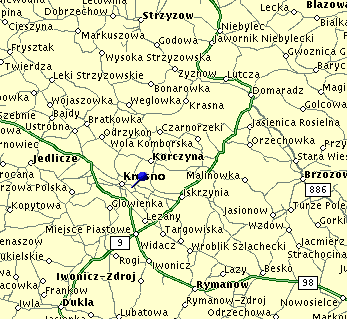 Dubiecko ,
Domaradz (10
Miles NE), Jasienica
Rosielna (9 miles NE), Haczow
(5 miles East), Brzozow
(10 miles East), Besko (10 miles
SE), Zarszyn (12 miles SE), Rymanow
(8 miles SE), Iwonicz-Zdroj (5
miles South), Dukla
(9 miles SW), Chorkowka (5
miles West) and
(Nowy) Zmigrod (12 miles SouthWest) Kolaczyce
(18 miles WNW) Most of these towns had large Jewish populations
until World War II. Those towns highlighted in blue have web sites
dedicated to them which you can visit by clicking on the town
name.
Dubiecko ,
Domaradz (10
Miles NE), Jasienica
Rosielna (9 miles NE), Haczow
(5 miles East), Brzozow
(10 miles East), Besko (10 miles
SE), Zarszyn (12 miles SE), Rymanow
(8 miles SE), Iwonicz-Zdroj (5
miles South), Dukla
(9 miles SW), Chorkowka (5
miles West) and
(Nowy) Zmigrod (12 miles SouthWest) Kolaczyce
(18 miles WNW) Most of these towns had large Jewish populations
until World War II. Those towns highlighted in blue have web sites
dedicated to them which you can visit by clicking on the town
name.
If you are visiting this page because your family came from Krosno you might want to read about the surrounding communities too, as in Galicia marriages were most often arranged between families from nearby towns; the young couple moved to one of the family towns. So even if, say, your great grandfather came from Krosno, it is possible that his people came from a neighboring shtetl! Thus on this site you will find information about most of the towns around Krosno.
This page is dedicated to the memory of the Jews of the Krosno Area....in August 1942 almost the entire Jewish population were killed or sent to Belzac. On this page you will find many lists -- 2900 Jewish people who lived in Krosno in the 1940s, and another of those who lived in Korczyna......most of whom perished in this catastrophe; still other lists are of those who survived.
I hope you will find all this interesting and helpful. Please
contact me if you have photographs or information to add, or any
questions by clicking on my name. As with any genealogical
research, this is an evolving project. Jeff Alexander, South
Carolina
Copyright © (2022) Jeffrey Alexander. All rights
reserved.
![]() Please note: This site exists because of your Jewish
Gen-erosity. Your tax deductible donation to JewishGen makes
these services possible. We spent a great deal of time
organizing this information so that your genealogical search
might be more rewarding....and you can reward us -- just click
on
Jewish Gen-erosity.
Please note: This site exists because of your Jewish
Gen-erosity. Your tax deductible donation to JewishGen makes
these services possible. We spent a great deal of time
organizing this information so that your genealogical search
might be more rewarding....and you can reward us -- just click
on
Jewish Gen-erosity.
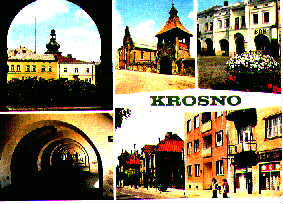
 updated 11/06
updated 11/06
 Sept 2018
Sept 2018 
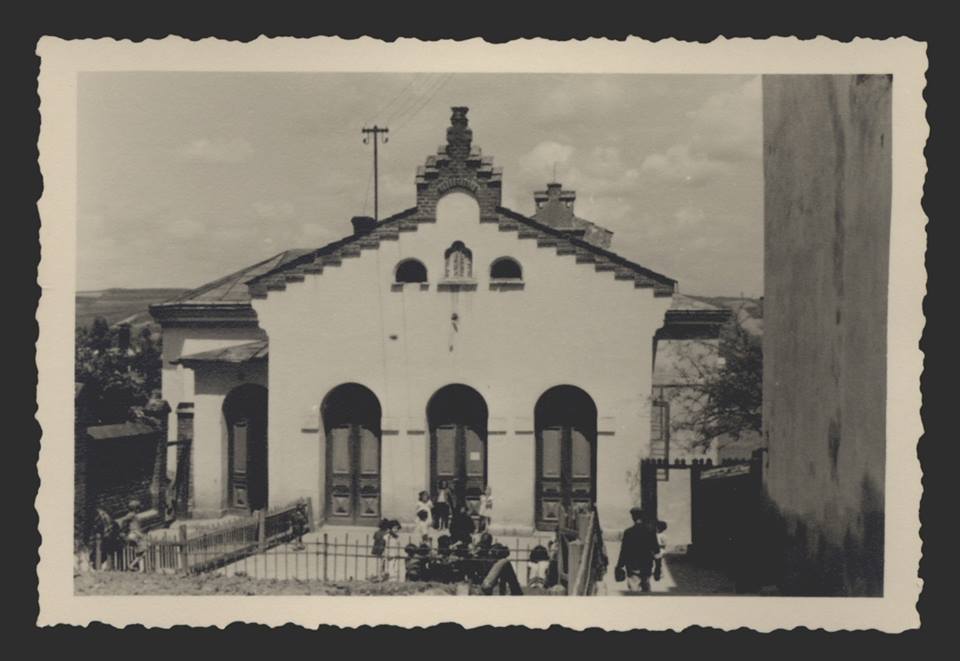
 Nov10
Nov10 
 And, 8/04
we've added the memoirs of Jacob Herzig...a fabulous piece!
And, 8/04
we've added the memoirs of Jacob Herzig...a fabulous piece!

 including
Yad Vashem, the USHMM, the International Tracing Service,
JewishGen’s Holocaust Database & Global Registry, Yizkor
Books, the Camps & Ghettos, YIVO, Joint Distribution
Committee and the Jewish Historical Institute in Warsaw
including
Yad Vashem, the USHMM, the International Tracing Service,
JewishGen’s Holocaust Database & Global Registry, Yizkor
Books, the Camps & Ghettos, YIVO, Joint Distribution
Committee and the Jewish Historical Institute in Warsaw
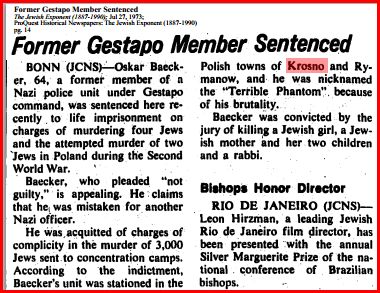

 December 2017:
we have found her second cousin. The Israeli branch of the
family supposes they may know who Maria's parents were, and
this is what we are checking out now. The find came about by
way of a new DNA match for Maria that came up on GEDmatch. A
JRI-Poland data file provided by Stanley Diamond gave the
key information, by which we were able to connect the two
families. It is your input, along with those of others who
came forward to help, that gave me the encouragement to
continue on with what seemed to be "the impossible" -
finding Maria's identity. Thank you very much. Sheindle Cohen.
December 2017:
we have found her second cousin. The Israeli branch of the
family supposes they may know who Maria's parents were, and
this is what we are checking out now. The find came about by
way of a new DNA match for Maria that came up on GEDmatch. A
JRI-Poland data file provided by Stanley Diamond gave the
key information, by which we were able to connect the two
families. It is your input, along with those of others who
came forward to help, that gave me the encouragement to
continue on with what seemed to be "the impossible" -
finding Maria's identity. Thank you very much. Sheindle Cohen.
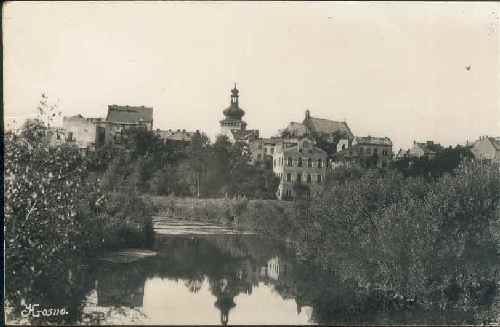
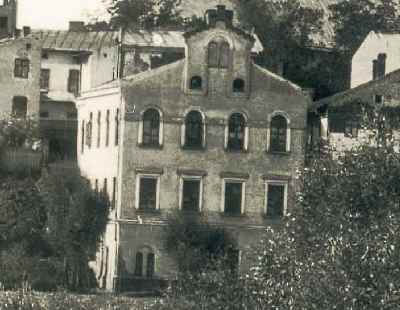
And this one, received in 2007 shows another view 
Thank you Micha! Isn't the Internet wonderful???!!!???
After the 2018 conference in Poland, Ruben Weiser went to the Podkarpackie Museum in Krosno. He wrote: “And they let me know the link for a 1932 old film of Jewish life in Krosno. The link is http://www.muzeum.krosno.pl/o-nas/archiwalia . The description below was made by the person in the museum”
It is a film made in 1932 by Krosno citizen Szymon MAHLER who emigrated to USA in 1913. After he married (Eva) in America, he wanted to show his wife his hometown, they come back here in 1932 and made this film. You will see most of all: members of Mahler and Trunczer families – they were butchers in Krosno, their house and shop close to the Parish Church.
First, there are few scenes on the ship. Simon and Eva where traveling with Simon’s cousins, Trünczers (family from his mother side), who were also visiting Krosno (neither Simon’s descendants, nor we know their particulars).
In Krosno We see three men in a place we call “the Dykes”, old Krosno sandbanks near river Wislok, very popular place of meetings. They appear later also, so they are probably members of huge Mahler/Trünczer family or officials from Jewish Community Council. I’m not sure, but one of these men looks like Mr. Bendet Akselrad, president of Jewish Community in Krosno. Later there are TRÜNCZERS from Bialobrzegi – family of Basha Mahler.
Simon presented the Old Market Square wonderfully. We were amazed while seeing this part for the first time. One can see 16th c. tenement houses and 19th c. architecture as well. We witness weekly Monday fair, organized in Krosno since the first half of 14th c., since king Kazimir the Great granted civic rights to settlement for our town. Old Square is filled with people, vibrant with life. Nowadays, it doesn’t look like this anymore… Traders, sellers & buyers came from small villages around Krosno, even from distant places. Peasants, smallholders, craftsmen. Selling their goods from wagons, wooden stalls, under the famous Krosno’s arcades from 16th c. and even just from a basket.
There are few seconds presenting so called “small market” on Franciscan Square (you will see a brick gate with large wooden doors – an entrance to Franciscan monastery). It was a center of Jewish ghetto during WWII.
The leading role in this film is taken by the Paul of Krosno Street. Wolf Mahler had his business and apartment on this street. Whole Mahler family is presented there. First, we see small groups walking in front of the butchery: older brothers with Simon, Mahler sisters (one with husband probably), and younger brothers. In most cases, we don’t know their names, with the exception of Simon’s younger brothers’ names – I found them in our Register Office: they are Fulek, Fischel and Moses). Later, there are scenes in the backyard of Mahlers’ house. This small garden was situated just opposite to the Synagogue. Unfortunately, we can’t see Krosno boznica, because this view is blocked with trees and bushes. And there is only one, very characteristic element of the Synagogue’s architecture seen – a triangular top of the roof above the entrance. One can see it over the Mahlers’ heads. In this backyard we see Wolf and Basha. Later, Simon’s mother with his sisters and their children. Next, Basha with grandchildren.
Paul of Krosno Street was situated in the middle of grand route to the Old Market Square, between Pilsudski Street and Slowacki Street. On the first one – there was the parish church situated, on the second one – there was the Synagogue. Paul of Krosno Street was and still is joining those two roads. We can see fragments of these streets on the film. From time to time, we see a fragment of unofficial symbol of town – 17th c. belfry tower (one can see the grand floor of the tower), situated in the nearest neighborhood of Krosno parish church (and later in the film there is one great shoot of our church and old church wall). And now and again, there are also apartment houses and small wooden building seen, located closely to the Synagogue on Slowacki Street.
There is one scene of departure – Eva, Simon’s wife and (probably) someone from the Trünczer family are in a hansom, they were given flowers. Destination is unknown. We cut the scenes that were not from Krosno. Though there was nothing specific about presented architecture in this part of the film, we think it had to be a town not that far away from Krosno – Kraków or Przemysl maybe. The most spectacular scenes for us are the scenes of the summer festival. On the Square we see vivid, cheerful crowd, wonderful parade of various characters: Indians, heroes from old Polish fairytales, people in national (historic, noblemen’s) and traditional (folk) costumes. It was The Festival of song and folk music, organized by District Council of Country Youth Association. It was the greatest and the most important cultural event of the year in the whole region.
Later, Mahlers’ backyard. Full of anonymous characters, probably neighbors, friends. We don’t know their names. And there’s another gem – we see an official preparation for the arrival of Polish president – Ignacy Moscicki. He was invited for the ceremony of unveiling of the monument of Ignacy Lukasiewicz (the inventor of kerosene lamp, for all his life linked with Galicia Region and Krosno - he organized the first oil mine in the world, close to Krosno). He sent a messenger – general Ferdynand Zarzycki from the Ministry of Industry and Trade. Even though the president did not appear, the scene is important to us - we see town’s officials under the banner: “Welcome Mr. President”. There are: our mayor, the chairmen, Krosno Town Council nervously awaiting his arrival. There is one division of (Strzelcy Podhalanscy) Podhale Shooters, hundreds of citizens. A fat guy with a strange hat is a president of famous Gymnastic Society ‘Falcon’ (organized in every Galician town in the turn of 19th and 20th c., preparing young people of Galicia for fighting back Poland’s independence). There are also members of Krosno Jewish Community. We see rabbi Samuel Ozhon FÜHRER with Tora. This was first and last rabbi of Krosno. He leaded Krosno Jews since 1901. He was murdered by Nazi, member of Gestapo, Oskar Becker in December 1942. During the most important ceremonies in Mahler family - he was present. He is buried in Jewish cemetery in Krosno. So are Wolf, Basha and some of their children and grandchildren.
Fantastic panoramic view of deserted Old Square is symbolic farewell with Krosno. It starts with south-western corner and a line of 19th c. apartment houses. Some of them however still resemble those older ones. On the south-eastern part we see the most representative 15th and 16th c. tenement houses. In the corner – small fragment of the Franciscan church. Next, there is eastern part of the Square with 19th c. Town Hall (building with tower clock). Last we see one small building of Market Hall. People are filmed on the northern part of the Square. There are also arcades presented – a traditional place of trade. One can see few stalls there.
The last part of the film is the parting. We see all Mahlers and Trünczer on Krosno railway station. There are also those men from the beginning of the film, rabbi and his wife, neighbors and friends probably. Simon left his family happy, in good health, smiling, weaving with flowers. All these people – they never see each other again.

Krosno was the home of my mother (Esther) and her extended Schiff and Hack family. Fortunately, she and my father (Rabbi Meyer Blumenfeld) came to the U.S. in 1927. Both of their families were brutally murdered back in Krosno and in Kielce (my father’s home) by the Germans.
In the past, I have had occasion to visit Poland four times (1986, 1987, 1996 and recently in July 2012). On my recent visit to Poland my son, Dr. Hal Blumenfeld, accompanied me. He took notes and some excellent photographs. I am pleased to be sharing some of them with you with the hope that they will prove to be informational. Also, perhaps they will serve as an incentive for us to further communicate with each other and perhaps even organize some sort of Jewish memorial together in Krosno.
Certainly, as Jewish descendants of Krosno we have a moral
obligation to maintain its Jewish cemetery. It is to that
cemetery that I draw your attention now. Back in 1986 when I
visited the cemetery, its condition was utterly scandalous. A
swastika was painted on its rusted entrance gate inside the
Jewish star. 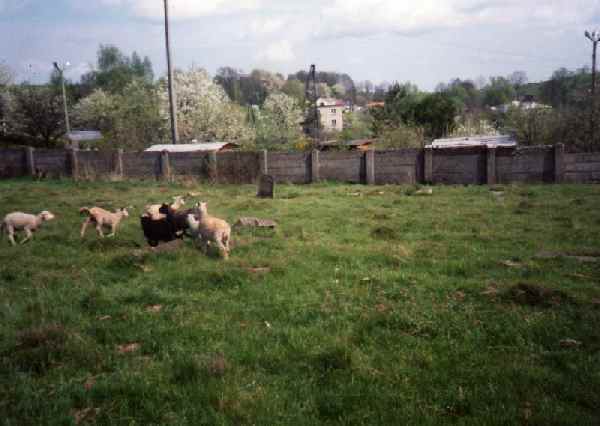 Sheep were grazing all
over the graveyard. Upon viewing the graves more closely, I
was shocked and deeply angered to see sheep droppings on
whatever gravestones were visible.
Sheep were grazing all
over the graveyard. Upon viewing the graves more closely, I
was shocked and deeply angered to see sheep droppings on
whatever gravestones were visible. 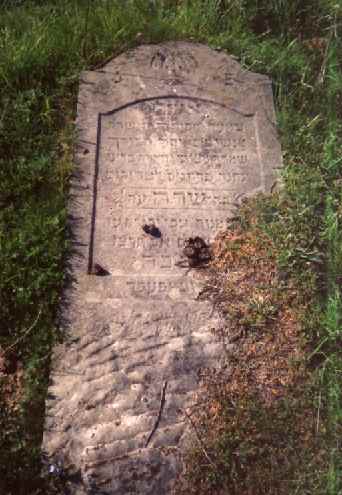
Back in 1986 and again in 1987, I complained about this
situation to the Polish Embassy in New York. In 1996 I
returned to Krosno with my daughter, Laura (Washington Post
writer). We went to the cemetery and it was covered with
brambles and bushes. We tore at them with our bare hands to
uncover the gravestones that I had previously discovered of my
great grandparents, Eliezer Dovid Hack (after whom I am named)
and Yehudis Hack. 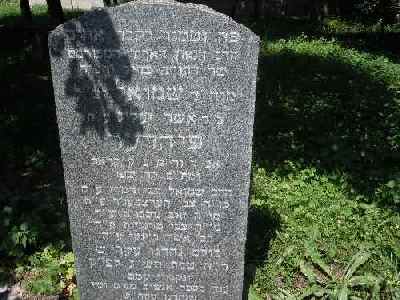 Ironically, the jungle-like condition of the cemetery had come
about because there were no longer any sheep present to munch
away at the growth. The Polish government had acted on my
complaint and that of others no doubt!
Ironically, the jungle-like condition of the cemetery had come
about because there were no longer any sheep present to munch
away at the growth. The Polish government had acted on my
complaint and that of others no doubt!
Fortunately, the cemetery is in fairly good condition now. Very much of the credit goes to a young Polish teacher from Krosno. What follows is a description given of his efforts:
“The change came in 2002 when a group 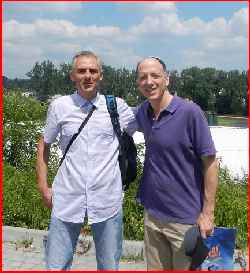 of young Krosnians (Olszowka), under the
direction of Gregory Bozka (local teacher and environmental
activist) went to work. With a little help from the
municipality and the Jewish communities over the next four
years until 2005 these young people sweated grubbing bushes
and removing rubbish. The renovated the cemetery gate and
mounted new and well-secured information boards, removed
unimaginable amounts of scrub and cut out tons of rubbish.
of young Krosnians (Olszowka), under the
direction of Gregory Bozka (local teacher and environmental
activist) went to work. With a little help from the
municipality and the Jewish communities over the next four
years until 2005 these young people sweated grubbing bushes
and removing rubbish. The renovated the cemetery gate and
mounted new and well-secured information boards, removed
unimaginable amounts of scrub and cut out tons of rubbish.
On 3 July 2005, the Embassy of Israel and the Jewish Historical Institute granted Grzegorz Bozkowi an honorary diploma for the activities to protect the heritage of Jewish culture in Poland. "This diploma is granted to extraordinary Poles, Polish organizations and cities, making the discovery of truth for many of the past and build a better future."
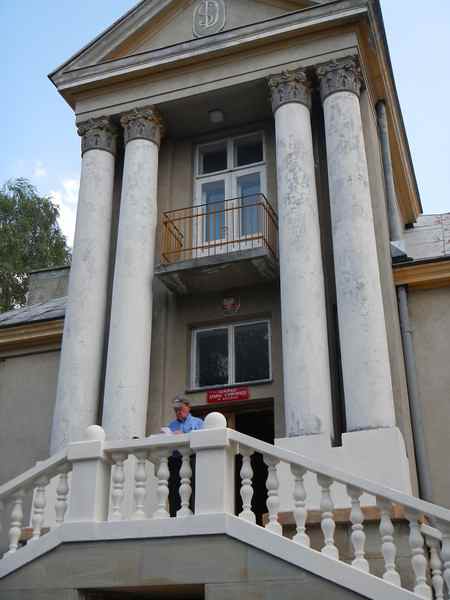 that contains archival records of births, deaths
and marriages. We went there and they found the recorded
handwritten entry of my great grandmother’s (Yehudis Hack) date
of death. I was able to obtain an official document of the entry
from the Records Office. Proviso - you must have an exact date
for your inquiry.
that contains archival records of births, deaths
and marriages. We went there and they found the recorded
handwritten entry of my great grandmother’s (Yehudis Hack) date
of death. I was able to obtain an official document of the entry
from the Records Office. Proviso - you must have an exact date
for your inquiry. 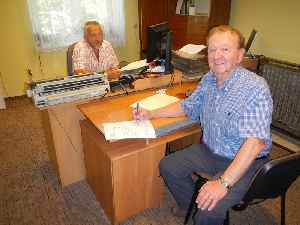

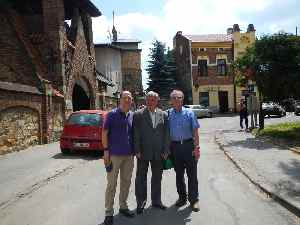 (market place square) supervising the
removal of the old cobblestone pavement there.
(market place square) supervising the
removal of the old cobblestone pavement there.
As for the synagogue that was located near the river, it
was torn down. In its place today is a bankrupt restaurant
(see photo below). We were told that any enterprise over
the years that was tried at that site ended in failure.
Maybe it’s time to restore the synagogue!! 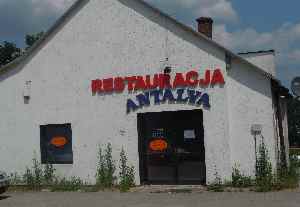
It was particularly gratifying to actually identify my mother’s childhood home located right off the Rynek. She always said that it was near a church and there it was just as she said! When I happened to ask the elderly person who was leaning out the window at the residence - who had lived there before the war, he said “Rabbiner, Rabbiner”. Well, that “Rabbiner” was my maternal grandfather, Rabbi Chayim Yitzchok Schiff, A”H.
There is so much more to tell but let this suffice for now.
Rabbi David L. Blumenfeld. (click on his name to contact the Rabbi)
We walked to 9 Francis Zkanska Street where Esther Blumenfeld lived with her family when she was a girl. Her father was Chaim Yitzhak Schiff, whom I am named after. Esther’s mother was Rezyl (maiden name Hack). Esther Blumenfeld described her family Shabbat table with her father at the head, three girls and the mother on one side of the table and the four boys on the other. She always said there was so much love in their home. She described the Shabbat candles in a candelabra that hung over the middle of the table and could be lowered each week for Shabbat. Esther loved telling stories about her childhood, the countryside, animals (kittens behind her house, cow wondering in town square, etc.). Krosno is way out in the country and Jews were not allowed into town officially until 1900. Before WWII there were only about 6,000 people living in Krosno but about 2,000 of them were Jews. Jews in the area lived before that in neighboring towns including our family (see below). The Hack family was in the timber/lumber business.
Chaim Yitzchak Shiff was a dayan, and used to travel to serve on batei din in the region. Getzl Schiff (Esther Blumenfeld’s first cousin, patriarch of Schiff family in Israel) told me some stories about Chaim Yitzchak: One time a family with a tavern lost their business because of an inspector. At that time Galicia was part of the Austrian empire under Franz-Josef. Chaim Yitzchak was known to have an excellent persuasive writing style, and also beautiful handwriting. He decided to write to the Tszar Franz Josef on behalf of the tavern owner. By doing this he was likely taking his life into his hands, since no one would dare write to the Tszar. Chaim Yitzchak implored Franz Josef to not leave the tavern owner with no way to support his family. To everyone’s amazement (most of all the inspector) the Tszar wrote back to Chaim Yitzchak, and also ordered the inspector to allow the tavern owner to resume his business. In another story, Chaim Yitzchak was once asked why he only shined the fronts and not the backs of his shoes. He replied that he shone his shoes so he can see them, and did not mind what other people saw on the backs of his shoes. Esther Blumenfeld also said that Chaim Yitzchak once was going on a journey and was worried about being attacked on the way by his fellow passengers in the coach. As he entered the coach he saw that another passenger was wearing a cross, and he felt reassured, since he felt that someone who believes in God would be inclined to do the right thing.
Esther Blumenfeld told other stories about her childhood
in Krosno. She loved to travel to the “big city” Krakow
where the fancy stores were, and buildings had the
“hoychah fenster” (high windows, meaning high class). One
time she was on the train back to Krosno on a Friday when
the train was delayed and Shabbat arrived. She would not
ride the train on Shabbat so got off in a small town along
the way. A poor Jew met her near the station and invited
her to spend Shabbat with his family. She described that
Shabbat as very depressing because the family lived so
poorly, but they were kind to her. After Shabbat she
continued on to Krosno, where her family were furious with
her for not coming back sooner since they were so worried,
but also very relieved to have her home safely. Esther
Blumenfeld also described how one time the Yiddish play
“The Dybbuk” was coming to town. She and her sisters were
excited to go to the show but thought their father would
not allow it, so they planned to go after he left for a
business trip. Shortly after he left the house they got
dressed up for the show and were about to leave when Chaim
Yitzchak reentered the house and announced he was not
going on the trip after all since he saw that “The Dybbuk”
had arrived in town!
During World War I her family had to move several times.
One time the Russians came looking for Chaim Yitzchak at their home (probably because as an important man they wanted to get rid of him), possibly at 9 Francis Zkanska Street. Somehow he found out they were coming and so he grabbed his tallis and tefillin and escaped through the second-floor back window. The boys were apparently not home so Reyzl thinking quickly smeared some oil on her face and the girls’ faces, and put cotton in everyone’s mouths and put everyone in one bed. When the Russian’s entered the home they thought the girls and their mother had fever from the mumps and quickly left the house. Another time, either the Russians or possibly Polish anti-Semites came to the house and they were again tipped off and this time the whole family escaped. When they came back to the house some time later they found the whole place ransacked, with the linens cut up and bloodied with goose blood.
Esther Blumenfeld also described the Synagogue in Krosno which had a river running behind it where she and the other children would play during davening. Esther also told the story of how her parents would not allow her to have pierced ears. So she decided to do it herself, using ice cubes to numb her ears before piercing them with a pin. Even as an adult many years later it was clear that her ear-piercing was not quite a perfectly symmetrical job!
Esther married relatively late for those days since she was in her late 20s. It is not clear why, possibly because she was independent-minded and particular about whom she married. In retrospect, if she had married younger to a wealthier man she might have never left Poland. Chaim Yitzhak apparently heard about the brilliant young Rabbi Meyer Blumenfeld from Kielce during his travels as a dayan. Esther recalled that when she first saw Meyer Blumenfeld she did not like the fact that he was wearing boots “like a Cossack” (he always admired soldiers). But apparently she got over it, since they were soon married. They had very little money as newlyweds and Rabbi Meyer Blumenfeld did not have a way to make much money in Poland. Esther’s uncle Julius Hack (Reyzl’s brother) had a lucrative furniture business in America and offered to pay for their journey there. Esther appealed to her father to allow them to move to America. He refused, saying that America is a “treyfa medina.” Not one to take no for an answer, Esther went to the town of Dukla near Krosno where there was a renowned Chassidic Rabbi, the Dukla Rebbe. She explained her situation to him and the Dukla Rebbe decided she and her husband should go to America. Esther Blumenfeld relished describing the scene when she returned home and told her father “Heh-heh-heh! We’re going to America!” Her father, furious said “what do you mean you’re going to America?!” She replied “The Dukla Rebbe said we should go to America” to which he had to agree.
At 9 Francis Zkanska Street in Krosno, we went inside
the hallway and looked around on the second floor (where
they likely lived), and out in the back. Esther Blumenfeld
described living in a house across from a church just off
the Rynek (main square) of town; according to my dad
during prior visits he investigated and the house at 9
Francis Zkanska Street was the only residence seeming to
meet this description; also when my dad on a previous
visit inquired from an older neighbor, he said that
“Rabina” used to live in the house at 9 Francis Zkanska
Street before the war.
Hal Blumenfeld
The Polish National Digital Archives has posted wonderful photographs from some of our shtetls in the 1920s and 1930s. You can search for your shtetl by going to http://www.audiovis.nac.gov.pl/obraz/; put the town name (as it is spelled today) in the box on the upper left hand corner. Each photograph is labeled and dated.
Our friend Monika, who was born in Poland, has translated
some of the captions, but you can do this too, by using
poltran at http://www.audiovis.nac.gov.pl/obraz/. Just cut
and paste the caption into the search box. The first
photograph is Krosno's main square in 1932 < img
src="PDAkrosno.jpg" width="800" height="554" hspace=2
vspace=2 align=right">
Next is a photograph in Jaslo, showing the laying of the
cornerstone for a Talmudic school in 1934. In the
photograph: Cadik from Bobowa, Ben Zion Halberstam, leader
of the kehilla, and Mr. Spirer. 
This 1929 photograph shows Ben Zion Halberstam with his
secretaries during his stay at a spa in Truskawiec. 
and this last photograph shows Krosno town leaders
Greeting the President of the Polish Republic, Ignacy
Moscickiego, in March of 1927. 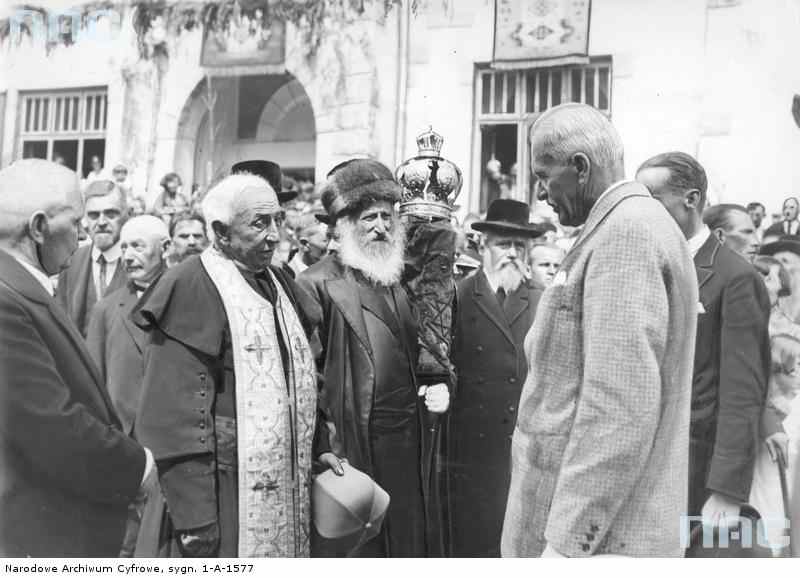
The American Jewish Joint Distribution Committee (JDC) was active in Eastern Europe during the 20th century. Recently the JCC has put its archives online. When you do a search at http://archives.jdc.org/archives-search/, the following surnames come up for Krosno:
Among the documents I found an interesting letter relating the [b]typhoid epidemic in 1921[/b]; the following are excerpts that may be of general interest:
Information reached my office on May 15th, that an epidemic of typhoid Fever broke out at Krosno, a small town in West Galicia, with a total population of 8,000 of which 2,000 are Jews...There are no hospitals in the city and the patients are being cared for at their homes....The generil sanitary conditions of ths city are primitive and poor. No water system nor sewers are there. Neither can be found a bath house....It was discovered that nearly all persons affected have been using the water from the local river (Wislok) for drinking purposes. The Epidemic was found concentrated among the Jews who dwell around the market place and who were compelled to use river water for their homes because of the fact, that the well Pump situated on the market place was out of order and their non-Jewish neighbours not allowing the Jews to draw water from their wells.
Upon the recommendation of the city physician, orders
were issued by the local authorities prohibiting the use
of the river water for consumption and that all private
wells should be free for public use. We furnished the
Jewish community, under the supervision, of the local
Jewish physician, a supply of lime, carbolic acid and
corrosive sublimate for disinfectiom...also a supply of 5O
suits of underwear, 50 sheets and 50 pillow cases and soap
for the use of the patients and their families, also
15,000 Mk. in cash.
We furnished 300 doses of antityphoid vaccine to the
Jewish physician Dr. Siegel for the purpose of Inoculating
all the contacts, thereby immunizing them against the
disease. Upon my request the Health Commissioner of Krakau
furnished Krosno two trained nurses Misses Dobrsanska and
Szulgenia who together with our sanitarian Mr, A.
Mlrowski, visited the affected families giving than
instruction to the care of the sick and how prevent the
healthy persons of becoming contaminated and infected
We also requested the local Jewish Communily to prohibit,
for the present, the use of the Mickvah by all persons
convalescent from Typhoid fever. The Community was also
requested to prepare a plan and budget for the
construction of a bath house in Krosno, thereby promising
them support in the undertaking.
signed, Dr Irvin Michlin
The description is at http://tracingthepast.org/minority-census. It reads: "Currently, the searchable data includes persons who can be proven to have perished in the Holocaust, those who were born prior to 1903 (+110 years ago), and others who deceased prior to 1984 (+30 years ago). Of the approximately 410,000 original entries, about 275,000 (or around 67%) of the "Minority Census" are available here online... Tracing the Past is honored to have the opportunity to share this research tool online. " and the index can be searched here:
http://tracingthepast.org/minority-census/census-database
The folks born in Krosno or small town around and living in Germany in 1939 included:
Up until 2019, Phyllis Kramer (OBM) developed and maintained this KahilaLink. Phyllis did a wonderful job documenting and sharing information about this shtetl. Starting in July 2021 Jeff Alexander is trying to fill Phyllis’ shoes. Please contact Jeff Alexander for anything related to this shtetl
Copyright © (2022) Jeffrey Alexander. All rights
reserved.